Shape stability of pasta phases (Vol. 50, No. 3)
Exotic non-spherical shapes of nuclear matter, so called pasta phases, are possible because of the competition between the short-ranged nuclear attraction and the long-ranged Coulomb repulsion, leading to the phenomenon of Coulomb frustration, well known in statistical mechanics. Such complex phases are expected in the inner crust of neutron stars, as well as in core-collapse supernova cores.
The authors of this work examine for the first time the stability of the « lasagna » phase, consisting of periodically placed slabs, by means of exact geometrical methods. Calculations are done in the framework of the compressible liquid drop model but obtained results are universal and do not depend on model parameters like surface tension and charge density. The stability analysis is done with respect to the different types of deformations corresponding to the eigenvalues of the deformation matrix.
Their compelling result is that this slab phase is locally stable in the whole density interval where pasta phases are present. Consequently, this specific phase could be present as a metastable structure in a larger density domain than previously expected, with potential important consequences on the resistivity of the crust and the cooling mechanism of neutron stars.
S. Kubis and W. Wócjik, Shape stability of pasta phases: Lasagna case, Eur. Phys. J. A 54, 215 (2018)
[Abstract]
Shaping the hilly landscapes of a semi-conductor nanoworld (Vol. 46 No. 5-6)
 Redeposition on hexagonally arranged dots
Redeposition on hexagonally arranged dots
A new study reveals how hexagonal-patterned, self-organised hill structures emerge in 2D at the nanoscale due to redeposition following semi-conductor bombardment with low-energy ions.
Nanoscale worlds sometimes resemble macroscale roller-coaster style hills, placed at the tip of a series of hexagons. Surprisingly, these nanohills stem from the self-organisation of particles – the very particles that have been eroded and subsequently redeposited following the bombardment of semi-conductors with ion beams. Now, a new theoretical study constitutes the first exhaustive investigation of the redeposition effect on the evolution of the roughening and smoothing of two-dimensional surfaces bombarded by multiple ions. The results demonstrate that the redeposition can indeed act as stabilising factor during the creation of the hexagonally arranged dot patterns observed in experiments. These findings have been published recently.
C. Diddens and S. J. Linz, Continuum modeling of particle redeposition during ion-beam erosion, Eur. Phys. J. B, 88, 190 (2015)
[Abstract]
Sharpening the focus in quantum photolithography (Vol. 45 No.2)
 Photolithography is used to etch circuits onto microelectronic devices.
Photolithography is used to etch circuits onto microelectronic devices.Credit: Tambako the Jaguar/Flickr
A new protocol, exploiting the quantum properties of materials, makes it possible to improve the accuracy of photolithography by addressing its physical limitations due to diffraction.
Photolithography uses light beams to design thin geometric patterns on the substrates of semiconductors used in microelectronic devices. This is achieved using a chemical reaction on a light-sensitive chemical, called photoresist. The trouble is that the phenomenon of light diffraction does not permit highly accurate patterns. Now, the author has developed a quantum lithography protocol designed to improve the resolution of this technology. The author establishes the formula for the probability of a single, and no longer multiple, photon transition from a bound state of a quantum system to a state of continuous spectrum, using the so-called Markov approximation. This makes it possible to select the exposure time and the beam’s intensity to obtain a narrow stripe in the photoresist on the substrate.
G. P. Miroshnichenko, “Quantum lithography on bound-free transitions”, Eur. Phys. J. D, 67, 257 (2013)
[Abstract]
Shedding new light on angle-selective Huygens’ metasurfaces (Vol. 49, No. 3)

Huygens’ metasurfaces form a class of ultra-thin optical devices which allow scientists to reshape the wavefront of an incident beam of light. Representatives of this class include highly efficient flat lenses, beam shapers, and holographic phase masks.
More specifically, such metasurfaces are composed of a carefully designed, two-dimensional arrangement of high-refractive-index dielectric nanoparticles, which show virtually no absorption losses and exhibit electric and magnetic dipole resonances known from Mie scattering. When these resonances are designed to overlap spectrally, the nanoparticles scatter almost all light in the forward-direction only, and thereby emulate the behavior of the forward-propagating elementary wavelets known from Huygens’ principle. The authors have investigated this effect in dependence on the incidence angle and polarization of incident plane waves for a metasurface composed of silicon nanocylinders. They showed that the resonance overlap can be designed to appear at an arbitrary incidence angle. Furthermore, since the metasurface blocks all light incident at angles other than the design angle, angle-selective functionalities may be implemented as well. These findings open interesting opportunities for the design of advanced wavefront-shaping devices and computer-generated holograms.
D. Arslan, K. E. Chong, A. E. Miroshnichenko, D.-Y. Choi, D. N. Neshev, T. Pertsch, Y. S. Kivshar and I. Staude, Angle-Selective All-Dielectric Huygens' Metasurfaces,
J. Phys. D: Appl. Phys. 50, 434002 (2017)
[Abstract]
Shortcut to adiabaticity with ultracold atoms (Vol. 42, No. 3)
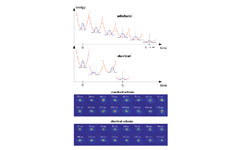 Top: Principle of
shortcut to adiabaticity.
The blue and red
curves represent the
BEC wave function and
trapping potential
respectively. below:
comparison of BEC
excitations produced
by standard and shortcut
decompressions.
Top: Principle of
shortcut to adiabaticity.
The blue and red
curves represent the
BEC wave function and
trapping potential
respectively. below:
comparison of BEC
excitations produced
by standard and shortcut
decompressions.
Adiabatic transformations are widely used in physics, and for instance are at the heart of the manipulation of quantum states. In such transformations, the Hamiltonian should typically vary slowly with time, such that the system always remains close to equilibrium. The drawback is the long transition time, which in some situations becomes unpractical due to finite lifetime or coherence time of the state under study. Alternatively, a "shortcut to adiabaticity" is a specifically designed temporal trajectory of the Hamiltonian, which connects the initial to the final state in a shorter time. The system is out of equilibrium during the transition, but the final state is identical to that obtained via an adiabatic transition (Fig., upper panel).
We have applied this strategy for the first time, to rapidly decompress an interacting Bose-Einstein condensate (BEC) held in a magnetic trap. Reducing the trap confinement also shifts the cloud vertically by a large amount, due to gravity. We implemented a 30ms-long trajectory designed for a 10-fold reduction of the trap frequency. Because of experimental imperfections, the final state we obtained is not an equilibrium one. However, we were able to demonstrate a large reduction of BEC excitations (dipole and breathing modes) when comparing the shortcut to other standard decompression schemes (Fig., lower panel). This trajectory was also shown to work for a thermal cloud with negligible interactions, hinting at the broad range of application of this technique.
Shortcut to adiabaticity for an interacting Bose-Einstein condensate
J.-F. Schaff et al., EPL 93, 23001 (2011)
[Abstract]
Signature of Fermi arc surface states in Andreev reflection (Vol. 49 No.5-6)

Weyl semimetals are conductors which are characterized by topologically protected conducting surface states. In contrast to three-dimensional topological insulators described by Z2 invariant, Weyl surface states inherit the chiral property of the Chern insulator edge states, similarly to the quantum Hall effect regime. To observe this difference in symmetry, we experimentally investigate charge transport through the junction between a niobium superconductor and a three-dimensional WTe2 Weyl semimetal. In addition to classical Andreev reflection, we observe sharp non-periodic subgap resistance resonances. From an analysis of their positions, magnetic field and temperature dependencies, we can interpret them as an analog of Tomasch geometrical oscillations for transport along the topological surface state across the region of proximity-induced superconductivity at the Nb-WTe2 interface. The crucial point is that observation of distinct geometrical resonances implies a specific transmission direction for carriers, which is impossible for trivial two-dimensional surface states in planar junctions without strict axial symmetry. In contrast, for Weyl chiral surface states the preferable direction is present, forming a specific transmission direction for surface carriers. Thus, observation of distinct geometrical resonances is a hallmark of the Fermi arc Weyl surface states.
A. Kononov, O. O. Shvetsov, S. V. Egorov, A. V. Timonina, N.N.Kolesnikov and E. V. Deviatov, Signature of Fermi arc surface states in Andreev reflection at the WTe2 Weyl semimetal surface,
[Abstract]
Silicon plasma wave receiver for terahertz wireless communication (Vol. 48 No. 1)

This paper presents the design, manufacturing and characterization of an integrated circuit (IC) that uses the plasma oscillations phenomena in silicon nanotransistors (Si-CMOS) for the detection of a 300 GHz-carrier-frequency wireless signal. We present the strategies for a Si-CMOS-based, wideband, integrated circuit receiver comprising: (i) a physics based, specific plasma-wave-transistor design, allowing impedance matching to the antenna and the amplifier, (ii) a patch antenna engineered through a stacked resonator approach and (iii) a broadband amplifier that uses bandwidth enhancement circuit techniques.
The receiver rectifies a 300 GHz carrier frequency, with a flat and very wideband response, up to10 GHz. This is, to the best of our knowledge, the first demonstration of a low cost 130 nm Si-CMOS technology, plasma wave transistors based, fast and wideband integrated circuit receiver operating at 300 GHz atmospheric window. The results pave the way towards future large scale, and cost effective silicon-technology based, high data bit rate, terahertz wireless communication receivers.
S. Nahar, M. Shafee, S. Blin, A. Pénarier, P. Nouvel, D. Coquillat, A. M. E. Safwa, W. Knap and M. M. Hella, Wide modulation bandwidth terahertz detection in 130 nm CMOS technology, Eur. Phys. J. Appl. Phys. 76, 20101 (2016)
[Abstract]
Single atom manipulations at the LT-UHV-4-STM (Vol. 47 No. 2)

The new ScientaOmicron LT-UHV scanning tunneling microscope is installed at Pico-Lab CEMES-CNRS (Toulouse) with its 4 STM scanners performing on the same surface. At 4.3 K, we report state-of-art STM experiments on Au(111) usually performed on the most stable single tip LT-UHV STMs. Operating the 4 scanners independently or in parallel with an inter tip apex distance < 100 nm, the ΔZ stability is better than 2 pm per STM. Single Au atom manipulations were performed on Au(111) recording the pulling, sliding or pushing signal. When contacting one Au ad-atom, a jump to contact leads to a perfect linear low voltage I-V characteristics with no averaging. Two tips surface conductance measurements were also performed with one lock-in and in a floating sample mode to capture the Au(111) surface states via two STM tips dI/dV characteristics. This new instrument is exactly 4 times a very precise single tip LT-UHV-STM.
J. Yang, D. Sordes, M. Kolmer, D. Martrou and C. Joachim, Imaging, single atom contact and single atom manipulations at low temperature using the new ScientaOmicron LT-UHV-4 STM, Eur. Phys. J. Appl. Phys. 73, 10702 (2016)
[Abstract]
Single-particle interference versus two-particle collisions (Vol. 43 No. 3)
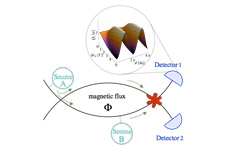 Electronic interferometer fed by two independent single-particle sources. The magnetic field dependent interference, as a function of the phase difference Φ, in the transmitted charge Q2 is found to be suppressed with the occurrence of particle collisions at time difference Δtu=0.
Electronic interferometer fed by two independent single-particle sources. The magnetic field dependent interference, as a function of the phase difference Φ, in the transmitted charge Q2 is found to be suppressed with the occurrence of particle collisions at time difference Δtu=0.
The recent experimental realization of an on-demand coherent single-electron source [G. Fève et al., Science (2007)] allows exploiting the individual particles' quantum nature in controlled single- and multi-particle effects in solid-state devices. In particular, it inspires to perform interference studies in electronic interferometers into which well-separated single particles - electrons or holes - are injected.
Stimulated by these possibilities, this article proposes a setup where the single-particle interference in an electronic interferometer is influenced by the presence of a second particle-emitting source placed in one of the interferometer arms. The two sources can be synchronized with respect to each other creating tunable and coherent modulation, and even suppression, of interference. Importantly, this study envisions and theoretically analyzes an experimental setup, in which both aspects of the quantum nature of electrons can be observed simultaneously: its wave-like and its particle-like behaviour. The time-dependent current shows an interference pattern, to which the second source adds a peculiar time-dependent phase determined by its working mode: this intriguing interference effect is convincingly explained by the particles' wave-like behaviour. Yet at the same time, a tunable coherent suppression of the interference is expected in the total transmitted charge, which is shown to be a feature of the particles' ability to collide. The coexistence of the two effects leading to interference suppression in the absence of dephasing is a fascinating challenge for our understanding of quantum mechanics.
Single-particle interference versus two-particle collisions
S. Juergens, J. Splettstoesser and M. Moskalets, EPL, 96, 37011 (2011)
[Abstract]
Single-photon observables and preparation uncertainty relations (Vol. 46 No. 5-6)
 Increase of uncertainty relations for circularly polarized Gaussian states as a function of the momentum spread. In the paraxial limit (ΔP→0) ħ/2 is retrieved
Increase of uncertainty relations for circularly polarized Gaussian states as a function of the momentum spread. In the paraxial limit (ΔP→0) ħ/2 is retrieved
The escalating requests for highly accurate manipulation of single photons call for an appropriate description of their observables. The authors provide a unified procedure for treating all single-photon observables in terms of Positive Operator-Valued Measures (POVMs), allowing for the evaluation of corresponding probability distributions.
The suppression of longitudinal (or equivalently 0-helicity) photon states is identified as a projection from an extended Hilbert space onto the physical one, carrying an irreducible spin-1 mass-0 representation of the Poincaré group.
POVMs are naturally obtained by applying such projections to Projection-Valued Measures (PVMs) associated to operators well-defined on the extended Hilbert space. Such operators are inherited from the familiar relativistic description of spin-1 massive particles and simply adapted to photons. Results show that PVMs of momentum and helicity remain unaltered, while those of position and spin are turned into POVMs by the projection, reflecting their intrinsic unsharpness. Finally, evaluation of uncertainty relations for position and momentum and probability distribution of spin over a broad class of physically relevant states is done, leading to new quantitative and experimentally measurable results.
G. Guarnieri, M. Motta and L. Lanz, Single-photon observables and preparation uncertainty relations, J. Phys. A: Math.Theor., 48, 265302 (2015)
[Abstract]
Six decades of cosmology (Vol. 49, No. 3)

The personal memories of Jayant Narlikar point to the need for restoring cosmology as the flagship of astronomy.
"Cosmologists are often wrong but never in doubt,” Russian physicist Lev Landau once said. In the early days, astronomers began by observing and modelling stars in different stages of evolution and comparing their findings with theoretical predictions. Stellar modelling uses well-tested physics, with concepts such as hydrostatic equilibrium, law of gravitation, thermodynamics, nuclear reactions etc. Yet in contrast, cosmology is based on a large number of untested physical assumptions, like nonbaryonic dark matter and dark energy whose physics has no proven link with the rest of physics. In a paper published recently, the author shares his personal reminiscences of the evolution of the subject of cosmology over six decades. He tells of the increase in our confidence in the standard model of cosmology to the extent that it has become a dogma. The German physicist Max Born said many years ago: "Modern cosmology has strayed from the sound empirical road to a wilderness where statements can be made without fear of observational check...”. The author feels that those comments apply very well to the present state of cosmology.
J. V.Narlikar , The evolution of modern cosmology as seen through a personal walk across six decades, Eur. Phys. J. H 43, 43 (2018)
[Abstract]
Slowing dynamics of a supersonic beam (Vol. 47 No. 1)
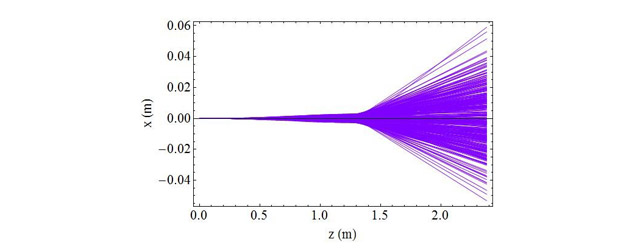
This investigation of the slowing dynamics of a supersonic atom beam by a counter-propagating resonant laser light is characterized by two special features: (i) a close coupling between simulations and experiments using a nozzle beam of metastable argon atoms, (ii) the use of a Monte-Carlo (MC) scheme aimed at analysing step by step the slowing process and describing in a realistic way atom random walks due to the spontaneous emission. It allows to calculate 2D images and radial profiles of the slowed beam, in good agreement with experiment. Other important characteristics as angular aperture, velocity spreads, coherence radius (not easy to be measured experimentally), etc. also result from the simulation. Since the 3D atomic motion within the laser field is considered, border effects, not directly accessible in a simple radiative force model, can be studied. The calculations, assuming a point-like source, reproduce the experimental characteristics of the slowed beam. In general a laser beam is an efficient tool to manipulate the atomic motion. Its interaction with atoms can be accurately characterized by the present MC-code. Actually any configuration combining resonant light and atoms is relevant (if the semi-classical approximation is valid). A “pushing” laser to generate a slow atomic beam from a magneto-optical trap has been successfully tested with metastable argon atoms. The MC-code predicts accurately the characteristics of the generated beam.
M. Hamamda, T. Taillandier-Loize, J. Baudon, G. Dutier, F. Perales and M. Ducloy, Slowing dynamics of a supersonic beam, simulation and experiments, Eur. Phys. J. Appl. Phys. 71, 30502 (2015)
[Abstract]
Small-worlds to analyze error-correcting codes on memory channels (Vol. 46 No. 1)
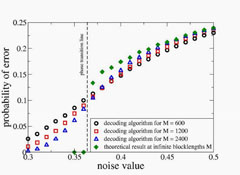
Low-density parity-check (LDPC) codes invented by Robert Gallager are error-correcting schemes that form the basis of today’s most promising communication systems. Their performance not only approaches Shannon’s theoretical bound, but they are based on computationally efficient encoding/decoding schemes.
While the literature behind LDPC codes is vast, it is based mostly on LDPC codes on channels without memory, i.e. channel noise acts independently on every bit. Memory in the channel noise is however a practical fact: e.g. the noise in wireless communication due to a moving source.
We have shown that decoding algorithms for LDPC codes on channels with memory can be analyzed using statistical mechanics. Memory introduces an extra set of degrees of freedom and the decoding problem becomes equivalent to studying phase transitions on `small-world’ networks. In this mapping the ferromagnetic-paramagnetic transitions represents the transition from success to failure of reliable communication.
Using replicated transfer matrices we derived the corresponding density evolution equations which determine the decoding performance at infinite block lengths (see figure). The theoretically derived critical values agree well with the practical implementation of the decoding algorithm. The phase diagram shows that the presence of memory can lead to superior decoding performance.
I. Neri and N. S. Skantzos, “On the equivalence of Ising models on ‘small-world’ networks and LDPC codes on channels with memory”, J. Phys. A: Math. Theor. 47, 385002 (2014)
[Abstract]
Smart multi-layered magnetic material acts as an electric switch (Vol. 48, No. 3)
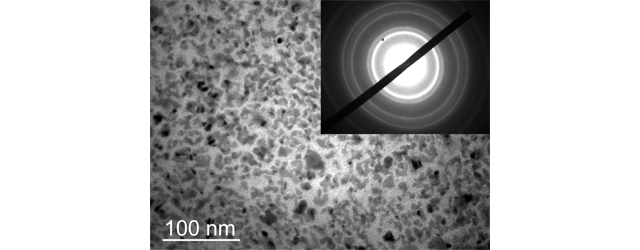
New study reveals characteristic of islands of magnetic metals between vacuum gaps, displaying tunnelling electric current.
The nanometric-size islands of magnetic metal sporadically spread between vacuum gaps display unique conductive properties under a magnetic field. In a study recently published, the authors found that the vacuum gaps impede the direct magnetic alignment between the adjacent islands — which depends on the external magnetic field — while allowing electron tunneling between them. Such externally controlled conducting behaviour opens the door for applications in electronics with magnetic field sensors – which are used to read data on hard disk drives – , biosensors and microelectromechanical systems (MEMS), as well as in spintronics with magnetic devices used to increase memory density. They found that the maximum values of the electric conductivity under an external magnetic field are obtained when the islands have a width of between 3 nm and 5 nm, with vacuum barriers of between 1 nm and 3 nm between them. However, they also observed that the tunnelling of electrons between the islands depends on the relative orientation of the direction of magnetisation in the adjacent islands and on the external magnetic field.
A.M. Chornous, Yu.O. Shkurdoda, V.B. Loboda, Yu.M. Shabelnyk and V.O. Kravchenko, Influence of the surface morphology on the magnetoresistance of ultrathin films of ferromagnetic metals and their alloys, Eur. Phys. J. Plus 132, 58 (2017)
[Abstract]
Solid deuterium surface degradation at ultracold neutron sources (Vol. 49 No.5-6)
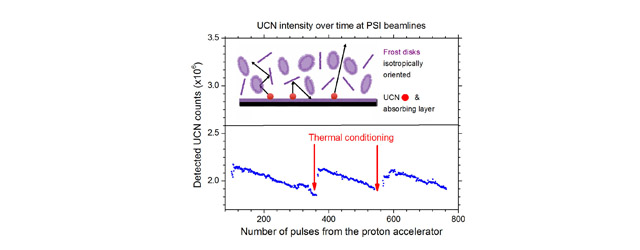
Highest intensities of ultracold neutrons (UCN) are in worldwide demand for fundamental physics experiments. Tests of the Standard Model of particle physics and searches for physics beyond it are performed with UCN.
Two of the leading UCN sources, at Paul Scherrer Institute (PSI) and at Los Alamos National Laboratory (LANL), are based on solid deuterium (sD2) at temperatures around 5 K. Here, together with NCSU they joined forces to understand UCN intensity decreases observed during pulsed neutron production. The study shows that the decrease can be completely explained by the build-up of frost on the sD2 surface during operation. Pulsed proton beams hitting the spallation targets generate heat pulses causing cycles of D2 sublimation and subsequent resublimation on the sD2 surface. Even very small frost flakes can act as total reflectors for UCN and cause an intensity decrease. Optical observation of the sD2 surface at NCSU – not possible at the operating spallation neutron sources – confirmed a severe surface degradation due to heat pulsing with an external heater in strong support of the frost model.
A. Anghel and 29 co-authors, Solid deuterium surface degradation at ultracold neutron sources, Eur. Phys. J. A 54, 148 (2018)
[Abstract]
Subcategories
- Highlights
- Vol. 41 No. 6 - Highlights
- Vol. 42 No. 3 - Highlights
- Vol. 41 No. 5 - Highlights
- Vol. 42 No. 1 - Highlights
- Vol. 42 No. 2 - Highlights
- Vol. 42 No. 4 - Highlights
- Vol. 42 No. 5 - Highlights
- Vol. 43 No.2 - Highlights
- Vol. 42 No. 6 - Highlights
- Vol. 43 No.1 - Highlights
- Vol. 43 No.3 - Highlights
- Vol. 43 No.4 - Highlights
- Vol. 43 No.5 - Highlights
- Vol. 43 No.6 - Highlights
- Vol. 44 No.1 - Highlights
- Vol. 44 No.2 - Highlights
- Vol. 44 No.3 - Highlights
- Vol. 44 No.4 - Highlights
- Vol. 44 No.5 - Highlights
- Vol. 45 No.1 - Highlights
- Vol. 45 No.2 - Highlights
- Vol. 45 No.3 - Highlights
- Vol. 45 No.4 - Highlights
- Vol. 45 No.5-6 - Highlights
- Vol. 46 No.1 - Highlights
- Vol. 46 No.2 - Highlights
- Vol. 46 No.3 - Highlights
- Vol. 46 No.4 - Highlights
- Vol. 46 No.5-6 - Highlights
- Vol. 47 No.1 - Highlights
- Vol. 47 No.2 - Highlights
- Vol. 47 No.3 - Highlights
- Vol. 47 No.5-6 - Highlights
- Vol. 48 No. 1 - Highlights
- Vol. 48 No. 2 - Highlights
- Vol. 48 No. 3 - Highlights
- Vol. 48 No.4 - Highlights
- Vol. 48 No.5-6 - Highlights
- Vol. 49 No.1 - Highlights
- Vol. 49 No.2 - Highlights
- Vol. 49 No.3 - Highlights
- Vol. 49 No. 4 - Highlights
- Vol. 49 No. 5-6 - Highlights
- Vol. 50 No. 1 - Highlights
- Vol. 50 No. 2 - Highlights
- Vol. 50 No. 3 - Highlights
- Vol. 50 No. 4 - Highlights
- Vol. 50 No. 5-6 - Highlights
- Vol. 51 No. 1 - Highlights
- Vol. 51 No. 2 - Highlights
- Vol. 51 No. 3 - Highlights
- Vol. 51 No. 4 - Highlights
- Vol. 51 No. 5 - Highlights
- Vol. 52 No. 1 - Highlights







